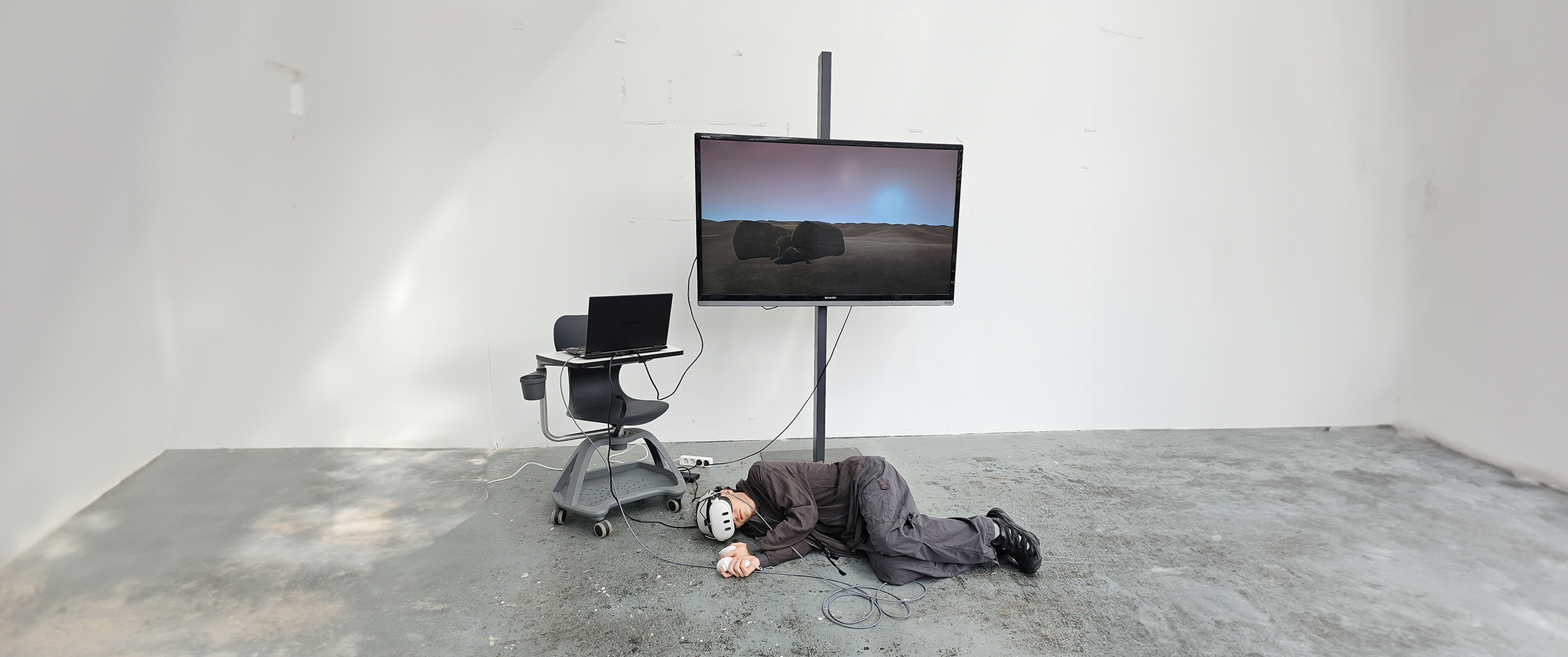
What if I Was a Stone
What if I Was a Stone (2024) is a performative experiment in digital translation and nonhuman embodiment. Using a custom-designed stone avatar within a virtual desert, I explore what happens when presence no longer takes human form, when the self is translated into something illegible, still, and unrecognizable. The project begins with a simple gesture: I put on a VR headset, lie motionless on the ground, and let my tracked movements animate a digital stone. From the outside, I disappear. What remains is the stone, framed by a context I created.
This act of becoming-object opens up questions about identity, authority, and legibility in digital systems. Can a stone hold presence? What happens when the avatar no longer performs recognizability? Drawing on Karen Barad’s theory of intra-action and Donna Haraway’s critique of dualisms, the work resists the idea of the human subject as the default center of digital experience. In this space, I am not controlling the stone, I am the stone. And what becomes visible is not me, but what the system is able to render.
In one iteration, I performed the piece during a live online class, embodying the stone silently while students continued their discussion. Over time, they began to forget my presence, or reinterpret it. The authority I held as a teacher did not vanish; it reconfigured. Students projected significance onto the object, and the environment itself began to teach. In this way, What if I Was a Stone asks not just what is lost in translation, but what is made possible when legibility is surrendered.
(I would rather be a stone than a Goddess.)
Documentation meditation as a stone
The Stone Project
This project questions the line between subject and object. By embodying the stone, I question line between a ctive human and passive object, rethinking identity and agency in virtual spaces. The concept of the stone’s sleep adds a new layer, showing how even passive states hold meaning in performative avatars.
"The machine is us, our processes, an aspect of our embodiment." Haraway, D. J. (1985)
I like to think that Stones Sleep
During the performance, I sometimes fell asleep while embodying the stone avatar. This “stone’s sleep” metaphor is a passive, meditative state of the experience. Sleep became a sign of immersion, creating conscious engagement and unconscious reflection, questions the idea of activity and rest.
"The boundary between science fiction and social reality is an optical illusion." Haraway, D. J. (1985)
Losing Myself
There is no value left in clinging to who I am. I have found a way to disconnect from the identity I inhabit. By becoming the stone and presenting only the stone, I dissolve my name, my personality, and my sense of self entirely. Instead of simply being, I shift into becoming. The illusion of my unitary self is disrupted. For the person observing me or it, who am I? Am I an object? What have I lost in this process? Perhaps everything.
"Cyborg imagery can suggest a way out of the maze of dualisms in which we have explained our bodies and our tools to ourselves." Haraway, D. J. (1985)
The Mind as Shaped by Influence
The empty virtual desert subtly influenced the experience through details like sand textures, imagined winds, and the stone’s stillness. These quiet forces shaped thoughts and mirrored how external inputs can subtly form identity and cognition. Embodying the stone's qualities, such as permanence and simplicity, encourages self-awareness.
"The cyborg is a condensed image of both imagination and material reality, the two joined centres structuring any possibility of historical transformation." Haraway, D. J. (1985)
Authority, Presence, and Power Dynamics
In an online class that I teach on the book Ways of Being, I embodied the stone avatar—remaining motionless and avoiding teacher interactions. This performance reimagined teaching as an experiment in presence and authority. By becoming a passive element, I question the teacher's role as an active authority figure, instead blending into the environment as an object to be observed, ignored, or engaged with.
Teaching as an Environment
Over time, students reported forgetting my presence as the stone avatar blended into the class "landscape," much like a stone in the physical world. This raises an important question: *What defines authority?
The stone, typically seen as passive, became the "master" of the session. My authority shifted from active engagement to presence and environment alone, rejecting the idea that teaching requires constant interaction. Teaching, in this sense, can become an environment, something that students navigate and engage with independently. This approach mirrors the jury I’m conducting now, where I create a space for participation rather than actively guiding every step.
"The cyborg does not dream of community on the model of the organic family, this time without the oedipal project.” Haraway, D. J. (1985)
Passive Yet Present
As the stone, I felt powerless, I couldn’t intervene, explain, or guide the class. I existed purely as an object. Yet, the students’ explained that I still held a form of power, subtle, passive, and rooted in presence.
An dynamic about authority: even without traditional markers of control or agency, my role as the teacher remained. My presence influenced the students. They projected authority onto the stone, treating it as both part of the class and a guiding force.
Experience as Flashes
During the session, I drifted in and out of sleep, experiencing the class in fragmented moments. These brief "flashes" of awareness, like grains of sand shaping a stone, subtly influenced the experience.
Similarly, the students’ perceptions of the stone avatar shifted, at times seeing it as a symbol of authority, and at others dismissing it as part of the background. Presence can be multifaceted: even in stillness and disengagement, my form shaped the dynamics of the space.
'S' - MA seminar PXL-MAD 2024 - 2025




